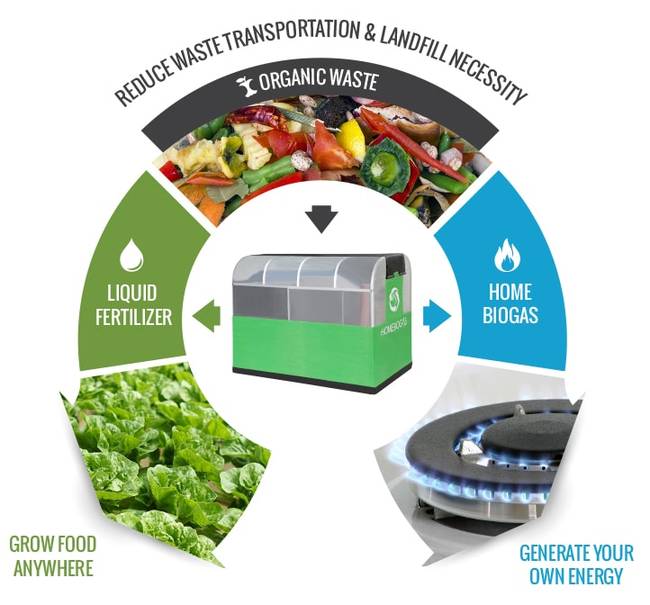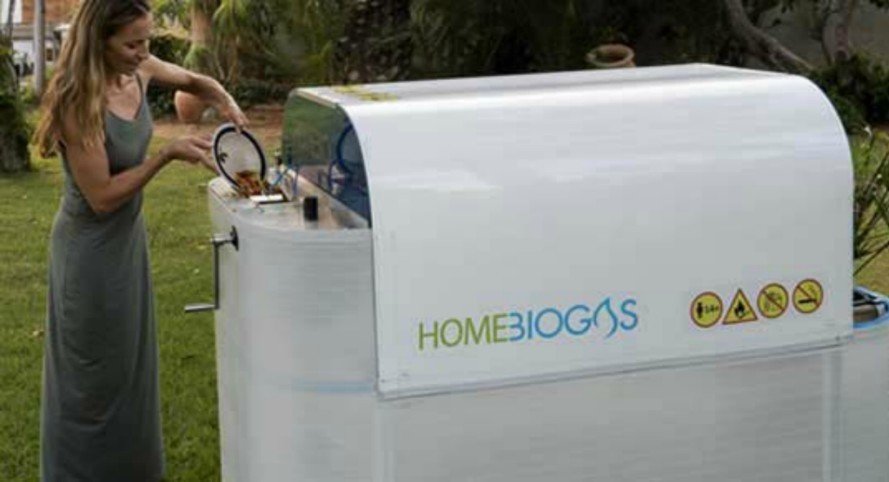The HomeBiogas™ Unit is a domestic biogas plant that uses organic waste to produce methane from organic matter. HomeBiogas plants can be used to reduce greenhouse gas emissions and provide a reliable source of methane for cooking and heating. They are easy to install and use, and can be operated without special training.
From the start, back in 2006, HomeBiogas digesters have been small, low-cost devices that can turn household organic matter, such as food scraps and compost, into biogas. The biogas can then be used to generate electricity or provide methane for cooking in a kitchen.
Home biogas digesters have evolved their technology tremendously over the years. But now, as before, using these digesters is an environmentally friendly way to reduce waste and help generate energy for your home.
Back in 2018, we wrote the following about this company's products. Over the last 4 years, we think that we have been proven right, as this company has become a leading supplier of this equipment, with many happy customers.
The current HomeBiogas model may look rather different but the archived article that follows remains a testament to the high quality and customer service offered by the company.
A new company named HomeBiogas is set to become a big player in the anaerobic digestion industry but tailored to home biogas requirements. For them, it is all about producing biogas in the home, or more accurately outside in the yard! Home biogas is widely produced in developing regions of the world. However, in the last couple of years, entrepreneurs have started to produce well-designed home anaerobic digestion plants for single homes in developed nations as well.

The “Fuel” is Simply Your Own Home Kitchen Scraps and Garden Waste
The feedstock chosen is kitchen scraps and green garden waste.
In particular Israeli startup, Home Biogas has developed a relatively affordable home-sized biogas unit that allows people to convert their own waste into fuel.
In Israel, temperatures get quite hot in summer, but where winter lows have included snowfall, it is not the best location due to the cold winters.
Reportedly, even Northern California winters can be cold enough to make the bacteria stop producing if HomeBiogas is outside. Choosing a sheltered sunny location in your yard or garden can make a big difference though.
Nevertheless, the start-up company Eco-gas Home Biogas has launched commercial biodigesters for the home and small institutions.

First Mainstream High production Volume Home Biogas System
Until now nobody has taken on the high-tech renewable energy technologies with a mainstream AD product. But, there is a strong argument for their unique business offer of low-cost renewable energy. Solar panels are expensive. This is even more true, now that solar panels will not be supported by the UK government for new installations after the end of March 2018. Due to the cessation of the UK Renewable Heat Incentive.
Home Biogas – Cheaper Initial Outlay than Solar Panels and Can Give a More Rapid Payback
Although the cost of each solar panel has dropped by about 30% in the UK, in 2017-18 even before the withdrawal of the subsidy for new solar panels, an average solar panel installation for a household would take 10 – 12 years to pay back the initial investment in solar panels.
In addition to the lower upfront cost of anaerobic digestion, home biogas does not require a grid-tie or any type of energy storage, as energy is stored in gas form and used on-demand when needed. On this basis, home biogas is certainly worth looking at, discussed in the remaining part of this article.
A Closer Look at the HomeBiogas Biogas Plant Renewable Energy System
HomeBiogas provides anaerobic digesters that convert kitchen waste and animal manure into cooking gas and liquid fertilizer.
According to the company information the standard AD plant offered which is simply called “Homebiogas” can use up to 6 litres (6 qt) of food waste or up to 15 litres (15 qt) of animal manure per day.
This is certainly more than an average UK family would produce in a day, and hence the HomeBiogas can instead be a community biogas project, where residents living in the same block can dispose of their food waste into the community HomeBiogas system.
HomeBiogas Plants for Rooftops and Verandas
The benefits from that could be in return, that they might get a supply of the digesters gas output piped into their homes. It is hard to see how this might physically be installed. For an average apartment block, it could be done at least in theory be located if the apartment had a reasonably sized rooftop area. Home biogas plants must not be situated indoors due to the safety hazard should the gas escape.
HomeBiogas do state that their digesters can be used in an urban environment, and located on rooftops.

Use Your Home Biogas Supply for Daily Cooking
On average, HomeBiogas can produce clean gas for up to 3 hours of cooking and 5-10 litres of clean natural liquid fertilizer daily. So, the output is quite definitely a worthwhile amount of fuel to have and to use in the home. But, one advantage should also be to reduce food waste.
Food waste is a huge problem in the UK, so it could be argued that a method to produce renewable energy and gain value from food waste, should be a candidate for government financial assistance. But, on the other hand, using any biogas digester may not be effective in reducing food waste.
That's because people might use the HomeBiogas system as a reason to not reduce the amount of food wasted, as they may tend to produce more. The more food waste the system is fed with, the more HomeBiogas can turn it into useful energy.
Use Your Home Biogas Plant Liquid Outflow to Fertilize Your Garden
HomeBiogas can provide between 5-10 litres of top-quality natural fertilizer each day.
Not everyone is going to find the output useful, normally called digestate it needs to be disposed of responsibly. If everyone with a home digester lived in flats and had no use for the fertilizer, it might get flushed down toilets. This would put a large and unwanted burden on sewage treatment plants.
HomeBiogas is an Ethical Company
HomeBiogas claims to be a socially-oriented company that cares about spreading biogas technology to all. They seem to be meeting that expectation very well.
The company is based in Beit Yanai, Israel. As a new company, they only manufacture digesters of a small size as backyard appliances that convert organic waste into cooking gas and liquid fertilizer. No doubt larger models will emerge from them at some future date.
Having already crowdfunded one backyard home biogas system that's now being used in more than 1,000 homes worldwide, HomeBiogas' is offering a new model that is their second Kickstarter. The new model designers focused on bringing a redesigned, more efficient and lower-cost version to mass production. They say that they also subsidize a percentage of the shipping cost to give you, the consumer, the lowest possible shipping price.
In addition to the biogas plant, a Chinese company Puxin provides the accessories you may also need including biogas storage and transport bags.
HomeBiogas Bio-toilet Now Also Available
This company now sells a toilet as an accessory to feed human waste into their home digester units, more about that here.
The HomeBiogas website is proving successful. Web Traffic by SimilarWeb Traffic Homebiogas is ranked 652,866 among websites globally based on its 64,947 monthly web visitors.
[Article originally published in October 2018. Updated August 2022.]






Hi,
I’m writing from Nigeria and would like to know where I can get the Biogas Plant in Nigeria.
Thanks
I suggest that you contact the manufacturer HomeBiogas at https://www.homebiogas.com and ask whether they have a stockist in Nigeria. If not I think they will ship a digester pack to you in Nigeria after they receive full payment. They say that: “The system is transported to the customers by air shipping. Shipping terms DDU (delivered duty unpaid), Door-To-Door service.”
We suffered a lot from mosquitoes and smell and complaints from our neighbors before we build the biogas plant. Our farm is clean now and the bad smell has gone. When I clean the swinery, the manure goes straight to the biogas digester and I use the slurry to fertilize the farm. It’s very good! We have been using biogas for 12 years during which nothing went wrong. It’s really good.
Thanks for your feedback. What a wonderful success story!
Free cooking gas! But, you do have to spend time mashing up all your kitchen waste and touring it into the tank each day. But, if you have the time and enthusiasm to do this over a number of years this can be very good.
Can you please contact me? I wld like to purchase one of you domestic complete systems.
Hi! Just follow the link to the company that sells the product. I don’t sell these. We do act as design consultants for larger commercial biogas plants, but not domestic scale. You need to contact the seller.
Hi I’m interested in off grid living
very informative article thank you.
I’m intrigued by the Home Biogas innovation, offering an affordable solution for turning waste into fuel. Living in India, where climate varies, I see potential, despite challenges like those faced in Israel and Northern California. The key, it seems, is finding the right spot at home to ensure it works efficiently year-round.
Hello everyone,
I’m trying to find a way to replace my domestic septic tank with a continuous digester to generate bioenergy. Can anyone in the UK point me to a system that may be suitable?
Kind Regards
Mike.
Mike: I see that you have used a UK email address, so I assume that your query relates to a septic tank in the UK?
Buried digesters to replace a domestic septic tank can work fine in hot countries, and you will see many diagrams that show just that, so I understand why you would think that replacing a UK domestic septic tank might work anywhere.
Unfortunately, in the developing world they simply flush with a bucket so dilution is minimal, and in the UK it is just too cold to get very much methane at all from buried biogas plants, other than in hot countries.
That’s just as well, because the large quantity of methane generated would escape from so many septic tanks that it would be a concern about greenhouse gas emissions!
However, it can be done. HomeBiogas does sell a biogas toilet. It is just that you would not be able to flush it with large volumes of water and therefore this is a special toilet with a hand pump, and I believe it uses digestate (grey water) for flushing.
It isn’t possible to fit it into the bathroom of a standard home without special plumbing from and to their home biogas plant. I don’t think that was your idea, but I don’t know of anyone in the UK that sells a biogas plant system for integration into a standard sewer system.
The fact is that warming up the large volume of water from a flushing toilet, and enormously diluting the organic content before sending it to a digester, simply does not work!
nice article